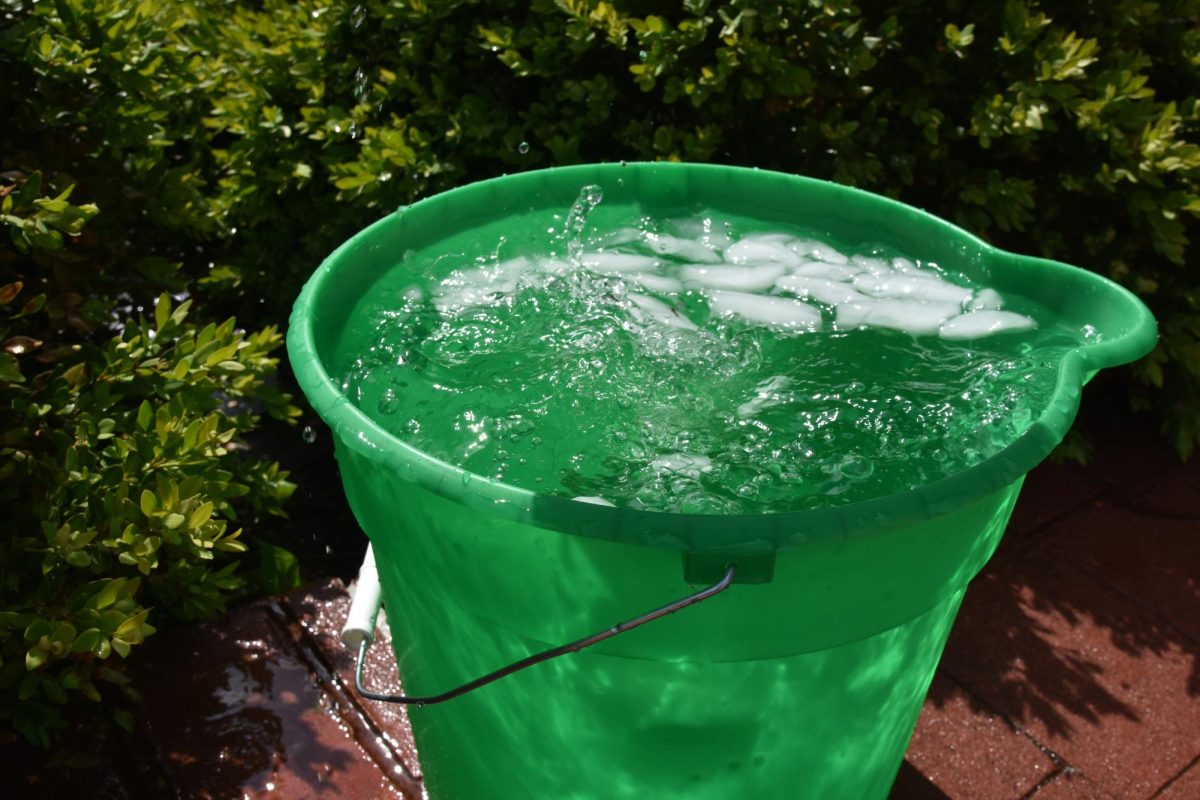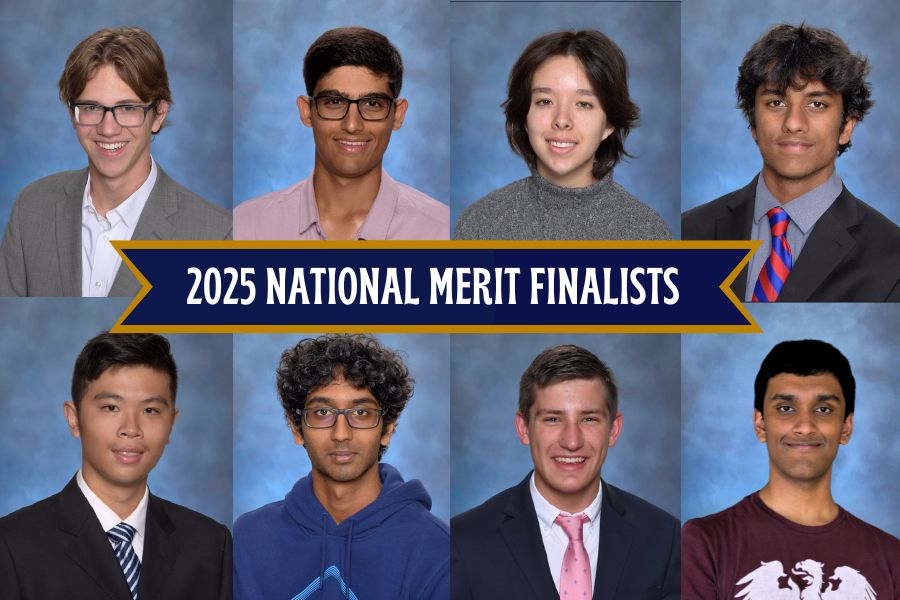After not qualifying for the annual VEX Robotics Competition, senior and president Paden Davis and his team, Twisted Metal, are taking their talents to the CREATE US Open Robotics Championship April 4 to compete against international teams.
Despite a small turnout at the beginning of the year, increased recruitment allowed them to keep competing competitively.
“Last school year, we started with only three returning team members and quickly grew the membership to 24 students,” sponsor Chris Donaldson said. “We advertised through [Longhorns Sports Production’s] (LSP) announcements, flyers and word of mouth. Team members recruited like-minded friends and peers in high level math and science classes. We have a strong diverse group that brings a variety of skills and range of experience levels to the team.”
Due to varying requirements for the international tournament, Davis and his team made changes to their original design so that they were able to compete.
“It’s not held by the same people who do the state tournament, so it has slightly different rules. These rules can let you use a lot more parts,” Davis said. “So we have to [make] changes to still be competitive in a field that now has a bunch of things that weren’t included in the rules before.”
Coming off of last season, the team won VEX’s Best Design Award for their reverse double bar lift build. Despite this, their demise at state came down to the pre-loaded code for the Skills Challenge.
“In terms of the actual mechanical bit of the robot, I feel like we have a pretty solid [build]. We haven’t needed to fix it or add any changes to it. It’s the best that it can possibly be. At this point, it’s the autonomous [part] that we have to fix,” junior Bhargav Addagarla said. “That’s why we didn’t qualify for state. We just didn’t work that out and we got to that point too late, so we weren’t able to fix it by the time tournament happened.”
Another reason they’ve kept the same build is because of their more efficient use of the motors.
“With our last robot, we used a reverse double bar lift, [which has been] incorporated into every single design we’ve been using since because it’s a really nice design and it works with the gear ratios and it’s generally pretty easy to hook up four motors to it instead of six,” Addagarla said.
Addagarla believes that teamwork allows all members of the team to be able to contribute any way they can so the team can be successful.
“I value teamwork a lot. I feel like it’s necessary for any of this to happen—we have to be able to trust each other to be able to work off of each other [and] build our ideas,” Addagarla said. “For the first few weeks in, teamwork really helped because we had no idea what to do and then someone would [say],‘What about this?,’ and then we would do some research about it and then one person would say,‘What if we do this to it?’ and we’d change it a bit and that eventually gave us what we have right now.”
Likewise, Donaldson speculates that with the team composition will allow them to push to greater heights.
“Each of our competitive teams demonstrates creative problem solving and grit. Many students have found and are playing to their strengths,” Donaldson said. “They seem to have a healthy respect for their competitors abilities, and they don’t seem intimidated by them and don’t freeze during adversity or surprises. Both teams work very well together during meetings and competitions, build strong robot designs, and consistently adapt and improve.”
Additionally, Donaldson believes the teams strives more as competition level increases.
“Our team is building a reputation of rising to the challenge and doing the hard work of whatever it takes to get the job done. Each year, the competition games are more difficult, other teams boast more experience and bigger budgets, and the level of competition rises,” Donaldson said. “For the last two years, I’ve seen students spread their wings, compete at a high level, advocate for themselves, and have fun, very successful experiences.”
Despite all of their early preparations from the start of the year, since their driver will be absent for the tournament, they will have to improvise.
“For this tournament, everyone can go except for our current main driver, which is our president, Paden [Davis], because of prior commitments,” Addagarla said. “That can be an issue but [since] we have two drivers for our bot; I work the top half [and] he works the bottom half, we’ll have to train someone else to do it, but we already have a pretty good candidate, so we’re good with that.”
Addagarla hopes with a strong mechanical build and leadership that they will be more than prepared for the tournament despite the new competition.
“In terms of strengths, just about everything is okay with the bot, we can run with this and we’ve talked to the competition directors and we asked,‘Would VEX actually work here or would be it be better to buy our own stuff?,’ like FTC or FRC gear,” Addagarla said. “They were like,‘You can use VEX, it’ll get you there just fine, maybe change a few things to make it more geared to our tournament,’ but otherwise, we’re in a pretty good position. And because Paden can’t come to the tournament, but he can regularly help; he can help us out while not actually being there [at the tournament].”
Looking forward, Donaldson believes that the team has poised themselves for a bright future.
“Our team has built a wealth of knowledge and experience in a very short amount of time. Students have proven their ideas are strong and their abilities can deliver,” Donaldson said. “We’re actively collaborating with new West Middle School robotics teams and up and coming freshman. I really look forward to what lies ahead.”


![Attending a meeting after school, sophomore Kunal Addagarla makes adjustments to their robot. Twisted Metal was not able to qualify for the 2019 Missouri State VEX Championship, but they will be newcomers at the CREATE US Open Robotics Championship displaying teams from across the U.S. and China. “I would say teamwork is very important because we have different roles to fulfill," Addagarla said. "I'm one of the programmers for my team and I want to make sure that my code works [so I have to] test the robot occasionally. [Then] the rest of my team is building or researching various ways we can build a better robot."](https://pwestpathfinder.com/wp-content/uploads/2019/03/brother-900x600.jpg)
![Smiling in a sea of Longhorns, Fox 2 reporter Ty Hawkins joins junior Darren Young during the morning Oct. 3 pep rally. The last time West was featured in this segment was 2011. “[I hope people see this and think] if you come to [Parkway] West, you will have the time of your life because there are so many fun activities to do that make it feel like you belong here. I was surprised so many people attended, but it was a lot of fun,” Young said.](https://pwestpathfinder.com/wp-content/uploads/2025/10/Edited2-1200x798.jpg)
![West High seniors and families listen as a representative of The Scholarship Foundation of St. Louis, Teresa Steinkamp, leads a Free Application for Federal Student Aid (FAFSA) workshop. This session, held in the library, provided guidance on financial aid, scholarships and student loan options. “This event is very beneficial for any seniors who are applying to or considering applying to colleges after high school [because] the cost of college is on the rise for seniors and parents,” college and career counselor Chris Lorenz said.](https://pwestpathfinder.com/wp-content/uploads/2025/09/DSC_4478-1200x778.jpg)
![Senior Kamori Berry walks across the field during halftime at the Homecoming football game on Sept. 12. During the pep assembly earlier that day, she was pronounced Homecoming Queen. “I thought it was nice that the crowd [started] cheering right away. I know [my friends] were really excited for me, and my family was happy because typically non-white people don't win,” Berry said.](https://pwestpathfinder.com/wp-content/uploads/2025/09/DSC7046-Enhanced-NR-1200x798.jpg)



![Pitching the ball on Apr. 14, senior Henry Wild and his team play against Belleville East. Wild was named scholar athlete of the year by St. Louis Post-Dispatch after maintaining a high cumulative GPA and staying involved with athletics for all of high school. “It’s an amazing honor. I feel very blessed to have the opportunity to represent my school [and] what [it] stands for,” Wild said.](https://pwestpathfinder.com/wp-content/uploads/2025/05/unnamed-6-1200x714.jpg)
![The Glory of Missouri award recipients stand with their certificates after finding out which virtue they were chosen to represent. When discovering their virtues, some recipients were met with contented confirmation, while others, complete surprise. “I was not at all surprised to get Truth. I discussed that with some of the other people who were getting the awards as well, and that came up as something I might get. Being in journalism, [Fellowship of Christian Athletes and] Speech and Debate, there's a culture of really caring about truth as a principle that I've tried to contribute to as well. I was very glad; [Truth] was a great one to get,” senior Will Gonsior said.](https://pwestpathfinder.com/wp-content/uploads/2025/04/Group-Glory-of-Missouri.jpg)


